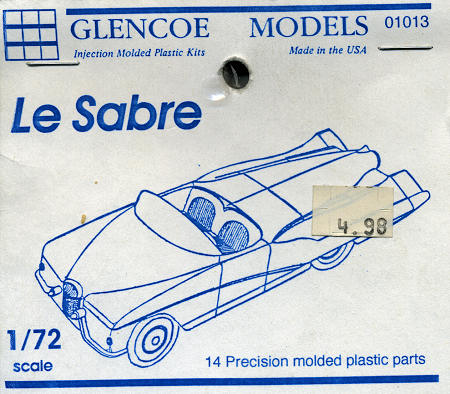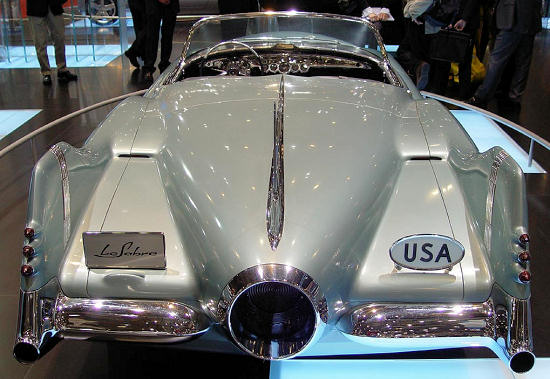
| KIT #: | 01013 |
| PRICE: | $4.98 |
| DECALS: | None |
| REVIEWER: | Scott Van Aken |
| NOTES: | This is an ex- Ideal kit. |

| HISTORY |
 The
1951 Le Sabre concept car's exotic presence has not diminished, nor
will designer Harvey J Earl's spirit be embarrassed by the technical
miracles of the last half century that have surpassed his creation. It is no
less splendid to see in motion. A thing of details, the Le Sabre still
delights amidst a wide selection of heritage vehicles available for display
from the rich GM stable of concept, racing, experimental and production
vehicles.
The
1951 Le Sabre concept car's exotic presence has not diminished, nor
will designer Harvey J Earl's spirit be embarrassed by the technical
miracles of the last half century that have surpassed his creation. It is no
less splendid to see in motion. A thing of details, the Le Sabre still
delights amidst a wide selection of heritage vehicles available for display
from the rich GM stable of concept, racing, experimental and production
vehicles. When
Le Sabre was new, a pair of Bendix Eclipse side-draft Carburetors carefully
metered two different fuels. At low or constant speeds one Carburetor drew
premium gasoline from an aluminium fuel tank lined with a rubber safety
bladder. When the accelerator was pressed over half its stroke a progressive
linkage opened the second carburetor, which drew from another
20-gallon-bladder tank filled with methyl alcohol (methanol). Presently, the
Supercharger has to make do with the gasoline system alone.
When
Le Sabre was new, a pair of Bendix Eclipse side-draft Carburetors carefully
metered two different fuels. At low or constant speeds one Carburetor drew
premium gasoline from an aluminium fuel tank lined with a rubber safety
bladder. When the accelerator was pressed over half its stroke a progressive
linkage opened the second carburetor, which drew from another
20-gallon-bladder tank filled with methyl alcohol (methanol). Presently, the
Supercharger has to make do with the gasoline system alone.| THE KIT |
 Rooting
around in the local hobby shop, I found this one hidden back behind some
other header card models in an in-frequently visited ares of the shop.
Overcome with stupidity, I bought it. Molded in a lovely turquioise plastic,
the kit itself is little more than a toy from the Ideal Plastic company from
years back. About a dozen parts makes this one up with a solid windscreen
just to make things interesting. The wheels are toy like and test fitting
the front bumper that detached itself from the sprue shows that it is pretty
much like a short run kit. Not for those easily intimidated or expecting a
rapid build. No decals, and the instructions are basically an exploded view
on the back of the header card.
Rooting
around in the local hobby shop, I found this one hidden back behind some
other header card models in an in-frequently visited ares of the shop.
Overcome with stupidity, I bought it. Molded in a lovely turquioise plastic,
the kit itself is little more than a toy from the Ideal Plastic company from
years back. About a dozen parts makes this one up with a solid windscreen
just to make things interesting. The wheels are toy like and test fitting
the front bumper that detached itself from the sprue shows that it is pretty
much like a short run kit. Not for those easily intimidated or expecting a
rapid build. No decals, and the instructions are basically an exploded view
on the back of the header card. | CONCLUSIONS |
Making this into an acceptable model will require a lot of dedication on the part of the builder, as well as considerable scratch building skills. Yet it is a model of a rather unique and still extant show care that if properly executed, can be a real beauty.
| REFERENCES |
The internet
October 2009
If you would like your product reviewed fairly and quickly, please contact me or see other details in the Note to Contributors.